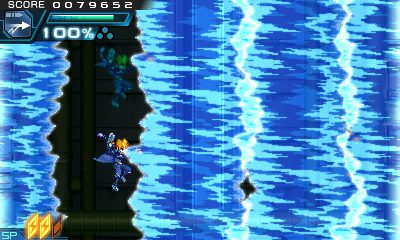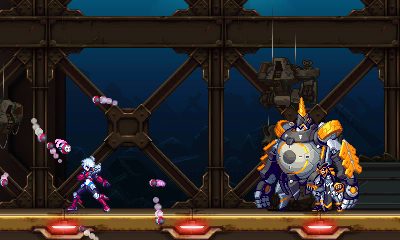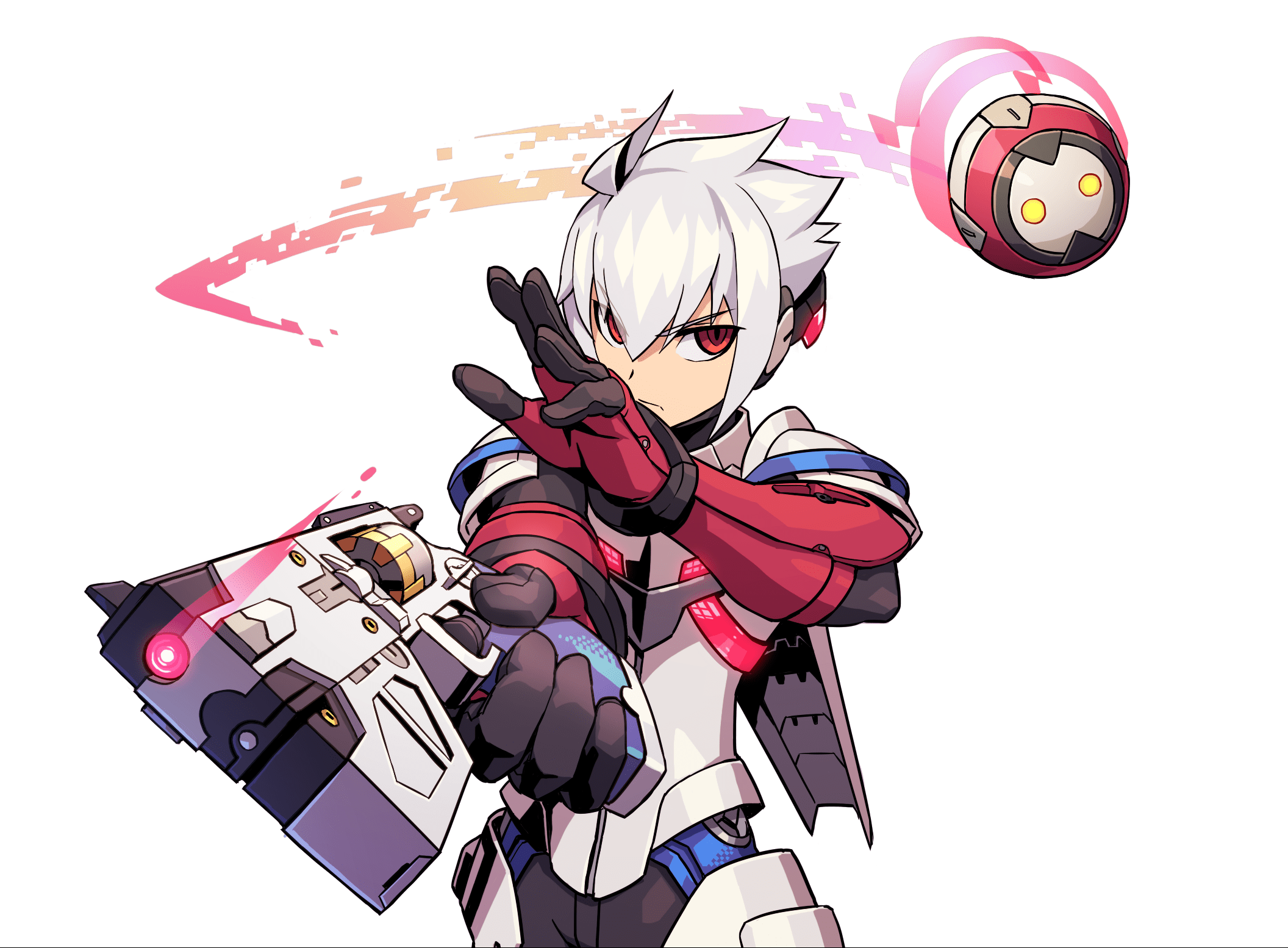There was once a definitive “glory days” of action platformers, permeated with excellent games such as Rayman, Donkey Kong Country, and most certainly Megaman. Over the years, the FPS became king, washing away all major improvements to the genre as most big development teams pushed the envelope for graphics and explosions. Even now, the game industry is still leaning on the cinematic side of gaming in the AAA market. Yet, in a small sect of independent developers, a storm of amazing, retro-inspired games swelled for many years. Azure Striker Gunvolt 2 is another wave in this storm.
It is hard to not compare Gunvolt 2 to the legacy it was built upon, Megaman X. Surprisingly, the team behind the Gunvolt series, Inti Creates, is also the team behind many Megaman Zero and Megaman ZX games. Throughout my time with Gunvolt 2, I kept making that connection to Megaman Zero, especially in the sprite design and characters, which makes sense since it is the same team. If you haven’t played any of those older games, do seek them out. Megaman Zero is one of the coolest, if not one of the most challenging, series on the GBA and knowing how these games work lay the groundwork for Gunvolt 2.
History lesson aside, Gunvolt 2 is a sequel to 2014’s fairly well-received Azure Striker Gunvolt, obviously, that takes place immediately where the first game leaves off. Starting this game, I was left blinking helplessly at the plot as there is little guidance to new players as to what is going on. Only a few Youtube videos I had seen on the first Gunvolt kept me even remotely clued in. Getting started, I quickly learned that while the plot might be cool for an anime, it definitely takes a backseat to game itself.
For those who have never played Gunvolt, the playstyle of our main hero (also called Gunvolt, but known mostly as GV) is a bit different from the usual jump-and-shoot fare. GV does have a pistol that he shoots like any other gun-toting hero, but his gun is just a means to an end. GV is an adept, with electrical powers that enable him to create electric fields around his body. His pistol fires metal tags, which can be spread among targets to blast them all with deadly arcs or piled onto a single target for more damage.
This simple switch in how GV approaches enemies is different enough to feel fresh to platforming veterans, while also creating some interesting puzzles in the stages. For example, one area has platforms that disappear when hit with electricity, forcing GV to make split-second decisions with his aura to keep from falling into danger. GV can also dodge incoming attacks, provided he has enough electrical charge left over. Players can replenish their charge by double tapping the down button. Figuring out the flow of tagging enemies, zapping them into oblivion, and recharging gives Gunvolt 2 an interesting pace that few games have.
 This buttery smooth control scheme is where Gunvolt 2 truly shines, but there definitely needs to be a mention of the visual style of the game overall. Character sprites are well animated, often having complex layers or subtle special effects. GV’s boots are constantly swirling with electricity, giving him an air of power, just with that little flair. Each character would fit right in with a popular anime, with crisp designs and interesting nuances in their dialogue. One character talks in a texting pattern, replacing “you” with “u” just to be brief. While few characters get a full arc of growth, these design choices add to their personality and the visual style helps portray that.
This buttery smooth control scheme is where Gunvolt 2 truly shines, but there definitely needs to be a mention of the visual style of the game overall. Character sprites are well animated, often having complex layers or subtle special effects. GV’s boots are constantly swirling with electricity, giving him an air of power, just with that little flair. Each character would fit right in with a popular anime, with crisp designs and interesting nuances in their dialogue. One character talks in a texting pattern, replacing “you” with “u” just to be brief. While few characters get a full arc of growth, these design choices add to their personality and the visual style helps portray that.
Battling these unique characters is half the fun of Gunvolt 2 and really the only challenge aside from the game’s completely optional Challenges. Each boss is also an adept, meaning they all have their own special powers and manipulations. One character wields a golem-like marionette, while another summons tridents of water. Each of these battles can be fairly intense, but are rarely frustrating. This is all due, mostly, to GV’s ability to dodge attacks automatically. As long as the player has enough electricity charged, they will rarely take damage aside from getting confused.
It’s also important to note that by default, boss battles have dialogue going on between GV and the other adepts. This is incredibly jarring and distracting, given the 3DS’s small screen and can lead to some frustrating deaths. Thankfully, the option to turn off these conversations is available. Doing so puts the game back to a fair view, at least to the point that the player can see incoming attacks. Once again, keeping the electricity gauge up is the main strategy in each fight, bringing us to the major flaw with Gunvolt 2 as a whole.
Gunvolt 2 is incredibly easy. Not even joking, the main campaign can be completed in about four hours, with limited deaths. The most deaths I suffered was from learning how GV played, while most of the time each boss can be bested with the same strategy. Tag them to max, hold the lightning arc, refresh electricity, wait til their below killing range with a special attack, repeat for literally every enemy in the game. If the player is somehow defeated, there is a mechanic built into the game that revives your character with unlimited electricity, provided you chat with Joule before each mission or so. As long as this revival is in reserves, just about every boss battle is a guaranteed victory.
 Being a veteran of the Megaman series, I was excited to see that GV acquires weapons after each boss. However, few of these weapons are as useful as the main weapon. For GV, he gains new ways to tag enemies, which is usually slower than using the default weapon and can mess up the flow the player has likely mastered. Not only that, but as far as I can tell, the bosses do not have weaknesses to particular weapons. It’s not needed since they’re incredibly easy, but it makes the upgrades fairly pointless. The only upgrades worthwhile are ones that affect the damage output of GV’s electrical aura, but most of these can’t be attained without repeating levels, so I never bothered to seek them out.
Being a veteran of the Megaman series, I was excited to see that GV acquires weapons after each boss. However, few of these weapons are as useful as the main weapon. For GV, he gains new ways to tag enemies, which is usually slower than using the default weapon and can mess up the flow the player has likely mastered. Not only that, but as far as I can tell, the bosses do not have weaknesses to particular weapons. It’s not needed since they’re incredibly easy, but it makes the upgrades fairly pointless. The only upgrades worthwhile are ones that affect the damage output of GV’s electrical aura, but most of these can’t be attained without repeating levels, so I never bothered to seek them out.
Gathering upgrades are the result of crafting from extra parts in between levels. These components are typically found by collecting medals hidden throughout the stage, giving the player an extra chance to unlock more items on a large grid after beating a level. Meaning, that even finding the most ridiculously hidden relic only warrants an extra chance, rather than something cool. This, coupled with the mostly uninspired level design, makes each level rather forgettable. There are some cool puzzle elements thrown in here and there, such as in the ice level, but overall few are interesting enough to write home about.
Mostly these levels lack danger. Even the fear-inspiring spikes laced throughout later levels rarely do enough damage to kill the player. While in almost the entire Megaman series, spike are instant death. This lack of danger means a lot of obstacles can be blazed through without worry, with killing enemies only needed to increase the final score. Score chasers may get more out of Gunvolt 2 than typical players, as there are a few minor reasons to revisit stages, but for the most part finishing the game once or twice will suffice.
Luckily, after beating GV’s story I tackled the rival character’s tale, Copen. Copen plays at a faster pace than GV, relying on flying into enemies to get increased damage and focus his aim. Copen’s special weapons are visually more impressive, such as blades of ice slingling energy blasts, or two massive drills that can provide a jump boost. Figuring out Copen’s unique mechanics were a fun addition to Gunvolt 2, but part of me feels like developing both campaigns took away from the game overall. If anything, Copen felt more traditional to me than GV, mostly because he uses distance to his advantage.
Now, plot wise, there are some interesting commentaries on music idols, more so in the last game than this one. That extra layer of depth is sorely missed as Gunvolt 2’s plot hits all the usual beats of an action anime. Chase down the bad guy who wants the pieces to an ultimate power, which will also return our partner Joule to her former power. The game’s forgiving nature would be more fulfilling if the plot was just a bit more cohesive and interesting. While the game’s engine is incredibly well coded, making each action feel fast and responsive, the game overall lacks the complexity that other games in similar genres had.
 As far as the game being easy, this comes as a surprise since I remember many of the Megaman Zero games being almost impossible and having fairly interesting plots. Beating a single level was a triumph for me, but in Gunvolt 2 I can blaze through an entire campaign in an evening if I really try.
As far as the game being easy, this comes as a surprise since I remember many of the Megaman Zero games being almost impossible and having fairly interesting plots. Beating a single level was a triumph for me, but in Gunvolt 2 I can blaze through an entire campaign in an evening if I really try.
Gunvolt 2 is more like an introduction to the action-platformer genre and less like a tribute to those classics of the past. Visually, the game has a lot to love and I can definitely recommend this one to fans of the genre or players who have never tried a game like this.
Just don’t expect the old-school challenge to be there.
Azure Striker Gunvolt 2 is available on the Nintendo E-Shop. A physical version entitled Azure Striker Gunvolt: Striker Pack is also available from Yacht Club Games, adding the first game to the cartridge as a bonus.
Speaking of bonuses, there is an additional challenge in Gunvolt 2 for those who have the Shovel Knight Amiibo. Take on this rather tough boss as a level one character in the Extras menu.








